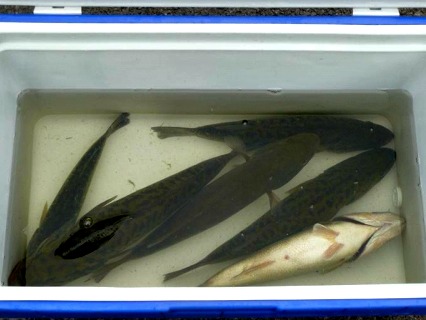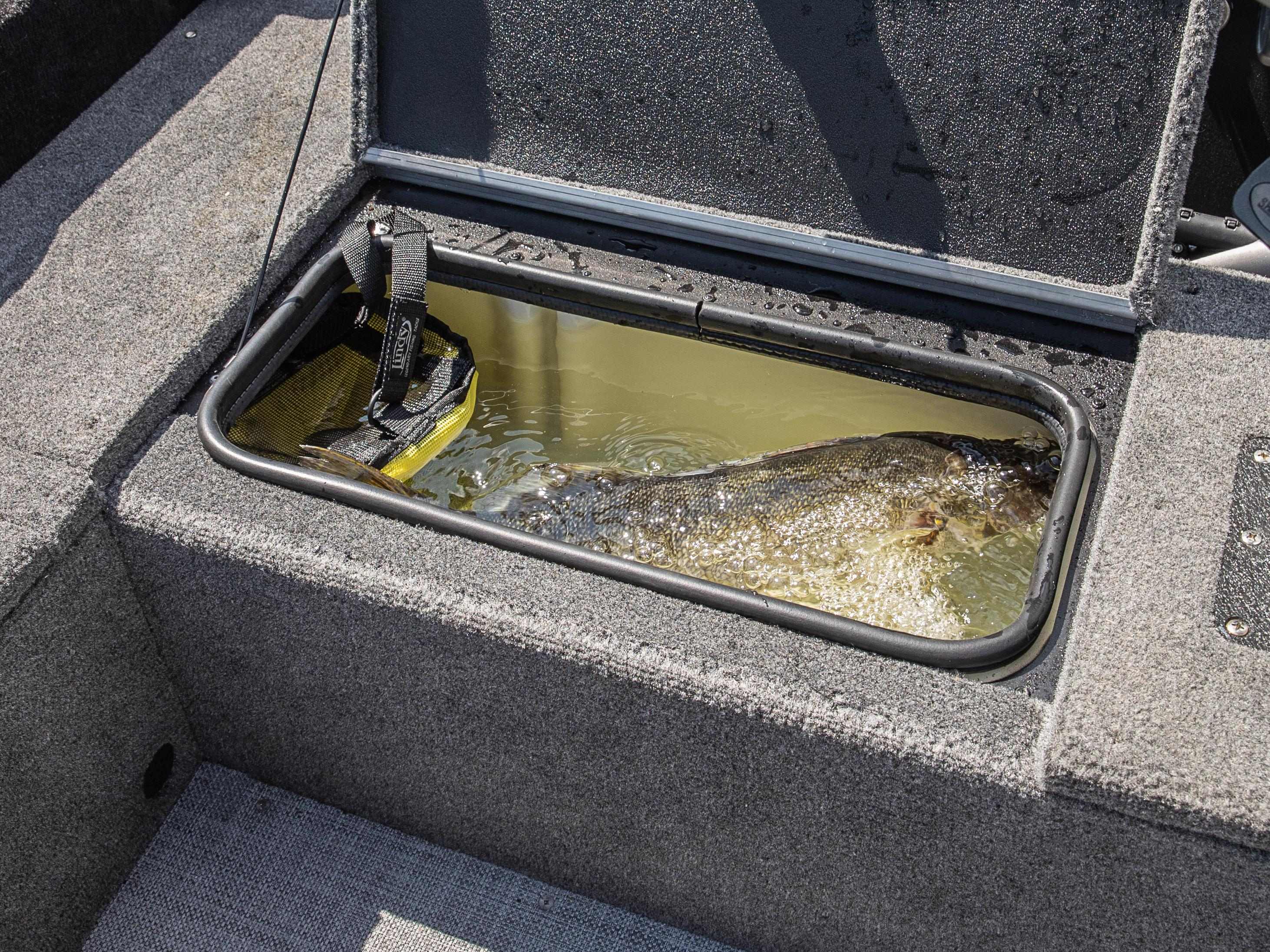How to Keep Fish Alive in Livewell

To keep fish alive in a livewell, ensure proper water quality and temperature, use oxygenation systems, and minimize stress during transport. When transporting fish in a livewell, make sure to maintain adequate water flow, avoid overcrowding, and handle the fish gently to reduce injury and stress.
By following these practices, you can enhance fish survival rates and maintain the quality of your catch. Now, let’s delve deeper into the steps you can take to keep fish alive in a livewell.

Credit: www.alumacraft.com
Proper Livewell Setup For Keeping Fish Alive
Properly setting up your livewell is essential to keep fish alive. Start by choosing the right size livewell that meets your needs. It is crucial to ensure sufficient oxygen levels in the livewell, as fish rely on oxygen to survive.
Additionally, maintaining the optimal water temperature is crucial for the well-being of the fish. Monitoring and adjusting the temperature accordingly will help prevent stress and keep the fish healthy. Remember, providing a comfortable and suitable environment for your fish will significantly increase their chances of survival.
By implementing these guidelines, you can help keep your fish alive in the livewell throughout your fishing trip.
Livewell Size And Capacity
Livewell size and capacity are crucial factors in keeping fish alive during fishing trips. Different fish species have varying space requirements, and it is essential to consider this when determining the ideal livewell capacity. It is important to avoid overcrowding the livewell as it can lead to stress, injury, and even death of the fish.
By providing sufficient space for each fish, you ensure their well-being and increase their chances of surviving until they are released back into the water. Understanding the fishing conditions and the specific needs of the fish species you catch will help you create the right environment in the livewell.
Adequate space, proper water circulation, and maintaining an optimal temperature are key to keeping the fish alive and healthy until the end of your fishing trip. So, remember to consider the livewell size and capacity in order to keep your caught fish alive and thriving.
Ensuring Sufficient Oxygen Levels
Proper oxygenation is crucial for keeping fish alive in a livewell. Aeration systems play a vital role in ensuring sufficient oxygen levels. Utilizing aerator pumps provides numerous benefits, such as efficiently oxygenating the water. Proper installation and positioning of these pumps are essential to maximize their effectiveness.
Aside from aerator pumps, there are other oxygenation alternatives. Adding aquatic plants to the livewell can enhance oxygen production. These plants release oxygen through photosynthesis, contributing to a healthier environment for the fish. Another alternative is using ice to cool the water and increase oxygen levels.
The cold temperature promotes oxygenation, helping to maintain the fish’s well-being. By implementing these methods, you can significantly improve fish survival rates in a livewell.
Maintaining Optimal Water Temperature
Maintaining optimal water temperature is crucial for keeping fish alive in a livewell. Understanding the impact of temperature on fish health is essential. Livewell heaters or coolers can be used to regulate water temperature effectively. Each fish species has its ideal temperature range, so it’s vital to know the requirements of the fish you are keeping.
When implementing temperature control measures, here are some tips to keep in mind: minimize stress during water temperature changes, make gradual adjustments, and use acclimatization techniques. By closely monitoring and managing the water temperature in the livewell, you can ensure the well-being of your fish and prevent any adverse effects.
Proper Livewell Maintenance And Fish Handling
Proper maintenance and handling of your livewell is crucial for keeping fish alive. Regular cleaning and disinfection are important to prevent the transmission of diseases. Minimizing stress during fish handling and transfer is vital to their survival. Take extra precautions to enhance fish survival rates after their release.
By following these guidelines, you can ensure the well-being of the fish in your livewell and increase their chances of staying alive. Keep your livewell clean, handle fish carefully, and use strategies that promote their survival after they are released.
Taking these steps will help maintain a healthy fish population and contribute to a more enjoyable fishing experience for you and fellow anglers.
Cleaning And Disinfection
Cleaning and disinfection are essential for keeping fish alive in a livewell. To ensure proper cleaning, you need the necessary equipment and choose the right cleaning agents. Thoroughly clean all the components of the livewell, leaving no room for bacteria or contaminants.
It is crucial to follow best practices for disinfection to prevent the spread of diseases among the fish. Regularly scheduling the disinfection process is of utmost importance to maintain a healthy livewell environment. Once the cleaning and disinfection are complete, rinse and dry the livewell properly.
By following these steps, you can maintain a clean and safe livewell, promoting the well-being and survival of the fish.
Minimizing Stress During Fish Handling
Proper fishing gear and techniques contribute to minimizing stress during fish handling. By selecting appropriate hooks and lures, you ensure a better chance of a clean and efficient catch. Implementing proper catch-and-release practices further reduces the stress on the fish.
When handling the fish, it’s essential to use techniques that minimize stress, such as supporting the fish’s weight and avoiding excessive squeezing or dropping. Wet hands and landing nets play a crucial role in reducing the removal of the fish’s protective mucus layer, which is vital for their health.
Lastly, avoiding injury and damaging the protective mucus can be achieved by using tools like dehookers and avoiding rough surfaces. Following these guidelines will help keep fish alive in livewells with minimal stress and improved chances of survival.
Strategies For Enhancing Fish Survival Rates
Strategies for enhancing fish survival rates include understanding the physiology of fish after release. Promoting fish recovery is crucial, and using revival tanks and pens can aid in their recovery. It is important to properly time the release of fish and monitor their behavior afterwards.
Encouraging participation in catch-and-release programs can also contribute to fish conservation. Conservation organizations and initiatives play a significant role in maintaining fish populations. Education and outreach efforts are instrumental in promoting sustainable fishing practices. By following these strategies, anglers can help keep fish alive in the livewell and contribute to the overall health of fisheries.
Frequently Asked Questions Of How To Keep Fish Alive In Livewell
What Keeps Fish Alive In A Live Well?
A live well keeps fish alive by providing oxygen and a suitable environment. Water and oxygen flow continuously through the well, delivering fresh oxygen to the fish to breathe. Additionally, the water in the live well is typically temperature-controlled to maintain an optimal environment for the fish.
The well should also have proper filtration to remove waste and maintain water quality. Aeration systems in the live well help in circulating the water and preventing it from becoming stagnant. It’s essential to ensure that the live well is large enough to accommodate the fish comfortably and prevent overcrowding, which could lead to stress and harm the fish.
Overall, a well-maintained live well provides the necessary oxygen, temperature, and cleanliness for the fish, ensuring their survival while in captivity.
How Do You Keep Fish Alive In A Livewell In The Summer?
To keep fish alive in a livewell during the summer, follow these tips: 1. Fill the livewell with fresh, cool water to provide a comfortable environment for the fish. 2. Add a livewell treatment to remove any harmful substances and maintain the water quality.
3. Ensure sufficient oxygen levels by using an aerator or adding ice to cool the water. 4. Minimize handling of the fish to reduce stress and avoid injury. 5. Keep the livewell shaded and well-ventilated to prevent overheating. 6. Avoid overcrowding the livewell to allow for proper circulation and reduce stress.
7. Monitor the water temperature regularly and take necessary steps to cool it down if it gets too warm. 8. Release fish that appear stressed or unhealthy to maintain the overall well-being of the fish population. Always practice catch and release if possible.
Taking these steps will help you maintain healthy fish in your livewell, even during hot summer days.
How Do You Keep Bass Alive In A Livewell In The Summer?
To keep bass alive in a livewell during summer, follow these steps: 1. Fill the livewell with cool water, not exceeding two-thirds of its capacity. 2. Use a livewell aerator or oxygen system to maintain proper oxygen levels. 3. Add ice packs or frozen water bottles to lower the water temperature and prevent heat stress.
4. Handle bass gently and minimize stress during retrieval and release. 5. Avoid overcrowding the livewell, giving each bass enough space to swim and breathe. 6. Monitor water temperature frequently and adjust accordingly. 7. Avoid using chemicals or additives that may harm bass.
8. Release bass promptly after weighing or measuring, ensuring they are in good condition. 9. Avoid prolonged exposure to direct sunlight. 10. Maintain livewell cleanliness by regularly changing water and removing debris. Following these guidelines will help keep bass alive and healthy in a livewell during the summer months.
Why Put Pool Noodles In Live Well?
Pool noodles are placed in live wells to protect fish from injury. The soft and buoyant noodles provide a cushioned barrier, preventing fish from hitting the hard surfaces of the live well. This helps minimize stress and reduces the risk of fish becoming injured or even dying.
Additionally, the pool noodles also help keep fish in an upright position, ensuring proper oxygen flow and preventing them from getting trapped or wedged in corners. By creating a safe and comfortable environment, pool noodles help maintain the health and well-being of the fish during transportation or storage in live wells.
It is a simple and cost-effective solution that fishermen use to prioritize the care and safety of their catch.
Conclusion
Proper care and attention are key to keeping fish alive in a livewell. By following the guidelines discussed in this blog post, you can ensure the well-being of your fish during transportation. Remember to use the right-sized livewell, provide adequate aeration and insulation, and minimize stress caused by overcrowding.
Additionally, regularly monitoring water quality, maintaining proper temperature and oxygen levels, and handling fish with care are all essential for their survival. By implementing these practices, you can extend the lifespan of your catch, allowing for a more sustainable and enjoyable fishing experience.
So, next time you head out on the water, prioritize the welfare of the fish you catch and contribute to the preservation of aquatic ecosystems.
